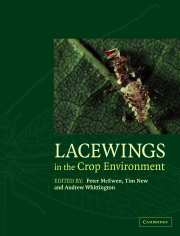Book contents
- Frontmatter
- Contents
- List of contributors
- Preface
- PART 1 Lacewing systematics and ecology
- PART 2 Lacewings in crops
- PART 3 Principles
- Introduction to Part 3
- CHAPTER 11 The use of lacewings in biological control
- CHAPTER 12 Mass-rearing, release techniques, and augmentation
- CHAPTER 13 Features of the nutrition of Chrysopidae larvae and larval artificial diets
- CHAPTER 14 Ecological studies of released lacewings in crops
- CHAPTER 15 Sampling and studying lacewings in crops
- CHAPTER 16 Interactions with plant management strategies
- CHAPTER 17 Lacewings, biological control, and conservation
- PART 4 Case studies
- PART 5 Conclusion
- Taxonomic index
- General index
CHAPTER 15 - Sampling and studying lacewings in crops
Published online by Cambridge University Press: 04 May 2010
- Frontmatter
- Contents
- List of contributors
- Preface
- PART 1 Lacewing systematics and ecology
- PART 2 Lacewings in crops
- PART 3 Principles
- Introduction to Part 3
- CHAPTER 11 The use of lacewings in biological control
- CHAPTER 12 Mass-rearing, release techniques, and augmentation
- CHAPTER 13 Features of the nutrition of Chrysopidae larvae and larval artificial diets
- CHAPTER 14 Ecological studies of released lacewings in crops
- CHAPTER 15 Sampling and studying lacewings in crops
- CHAPTER 16 Interactions with plant management strategies
- CHAPTER 17 Lacewings, biological control, and conservation
- PART 4 Case studies
- PART 5 Conclusion
- Taxonomic index
- General index
Summary
INTRODUCTION
Neuenschwander (1984) emphasised that much sampling and monitoring of lacewing populations in the past has not been strictly quantitative, but has involved collections to determine presence/absence and gross inferences on the relative abundance of various species on a crop or in an assemblage in an area or defined environment.
Nevertheless, for many purposes there is need for field assessments based on quantitative appraisal based on adequate, replicable sampling protocols, and continued monitoring to determine population sizes, changes in species abundance, phenological traits, and responses to change. Neuenschwander's account of such approaches and the techniques employed remains valid and applicable, and forms the basis for the discussion which follows. However, in the intervening years, the need for improved sampling to establish predictive capability has become more widespread in IPM, and the wisdom of monitoring the establishment, influences, and spread of biological control agents consolidated.
As in any sampling programme, the scale of operation and the precise questions being asked must determine the sampling regime and the intensity of sampling needed. ‘Sampling effort’ reflects both the duration and intensity of sampling. At the extremes, a single brief collection period may be all that is needed to confirm the presence of a given lacewing species on a crop whilst, at the other, continuous or interval sampling using a variety of techniques over an extended period (of one or more growing seasons or years) may be necessary to reveal population trends, phenology, and the relative abundance of the members of a complex of natural enemies, or the establishment of a newly introduced biological control agent.
- Type
- Chapter
- Information
- Lacewings in the Crop Environment , pp. 351 - 356Publisher: Cambridge University PressPrint publication year: 2001
- 1
- Cited by



